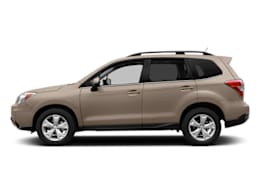Sticking to the basics, the Subaru Forester embodies the saying "a steady pace wins the race." It has always been a sound and practical vehicle, although its plain, unpretentious demeanor didn't help it stand out to car shoppers in this crowded field.
Subaru put function in front of form, resisting the contemporary trend toward making SUVs look like sports coupes with descending rooflines and curvaceous bodies. Instead, they focused on the fundamentals, with a space-efficient design, large windows and big square doors. That recipe resulted in the easiest access and the best view out of almost any vehicle. It also produced one of the roomiest rear seats in the class, with copious head and leg room.
Adopting various fuel-efficient technologies, including finally installing a continuously variable transmission, this version of the Forester delivered prompt acceleration as well as a class-leading 26 mpg overall and 35 on the highway. The mid-trim Premium package included plenty of handy features, including a power driver's seat, heated front seats, and a big sunroof at what was aquite reasonable price for the time.
Advanced safety equipment, including forward-collision warning with emergency automatic braking was included with the readily available EyeSight safety package.
For all its virtuous simplicity, however, this revised Forester had a few tradeoffs. The ride is rather firm and jittery, which is a change from the cushy-riding previous generation. The interior trim was modestly upgraded, but remained quite austere -- with a few cheap-looking touches.
Overall, if you're looking for a functional and fuel-efficient small SUV, the Forester is hard to beat.


























